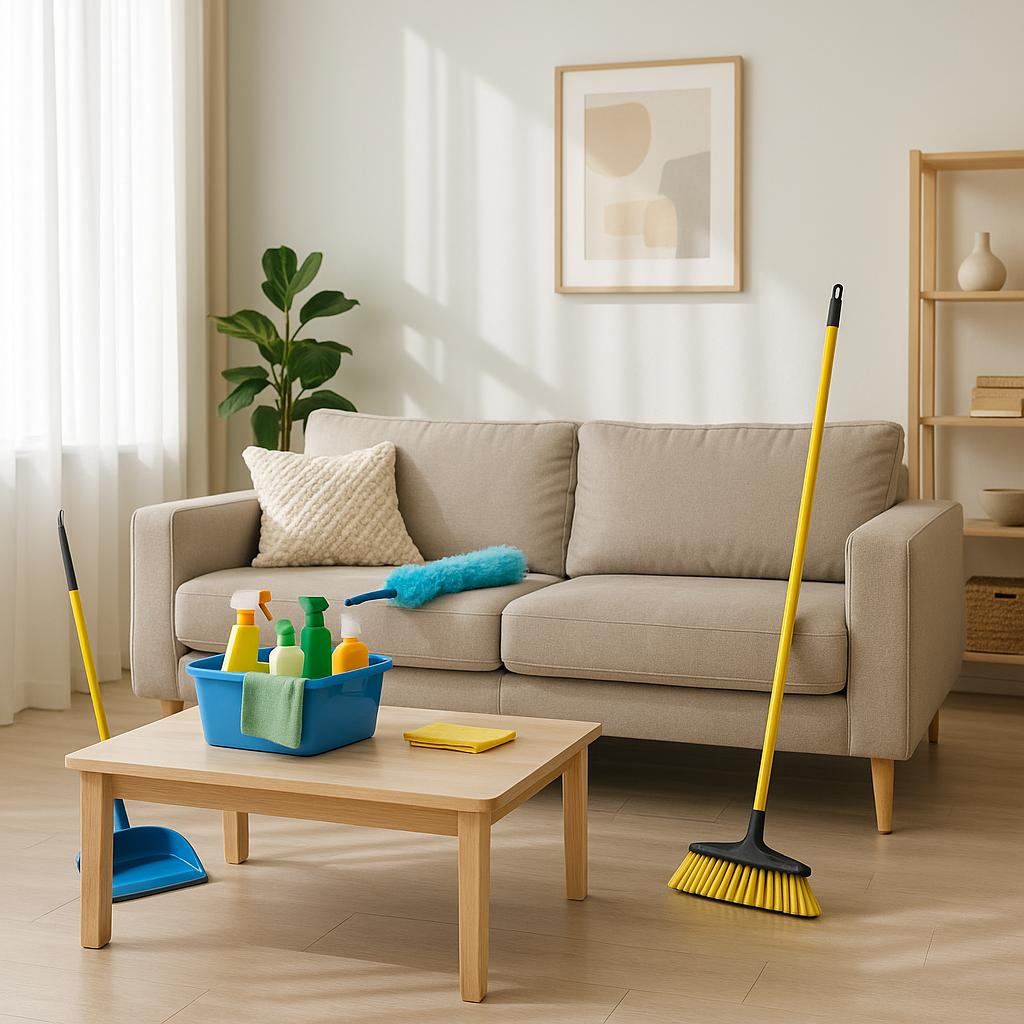
Quick Clean Rituals: 5 Steps to Keep Home Tidy
Having an immaculate home is not something that needs marathon cleaning sessions or expensive professional cleaning services. The trick is creating habitual micro-habits that combine easily with your current daily routine. These strategic methods turn overwhelming domestic duties into manageable maintenance moments, making it possible to have a consistently inviting home without losing valuable time or energy.
The new life necessitates that you do things in a most efficient way, even with home cleaning. Rather than wasting entire weekends on mega-cleaning exercises that tire you out afterwards, embracing short but efficient cleaning rituals within one day puts your house spick and span with minimal effort. The method is useful to working professionals, double-duty parents, and any person that is willing to make the most out of their leisure time without compromising on the cleanliness of their home spaces.
Home maintenance psychology demonstrates that routinized little behavior has more durable consequences than intermittent heavy-duty behavior. When cleaning occurs as a natural response rather than repugnant behavior to put off, your home is inclined with little conscious effort to perform up to standard. Such simple change of style ends tension concerning accumulation grime and creates a feeling of mastery and accomplishment.
The Morning Foundation Ritual
Beginning each day with reflective organizational actions creates a good energy that carries over into your whole home environment. This morning foundation that is established does not include complex procedures or wasting time on expenses, but its impact resonates within your living space throughout the balance of the day.
Upon waking, immediately address your bedroom by pulling up covers and piling up pillows. This simple chore, completed in less than three minutes, immediately upgrades your bedroom from appearing rumpled to sporting a sleek appearance. The mental benefit is more than superficial, as making your bed creates an immediate feeling of accomplishment that stimulates additional productive action during the day.
While your breakfast beverage is brewing, use the wait time to clean surfaces in sight of your kitchen. Wipe countertops clear, replace out-of-place items where they should be, and leave an empty sink of last night's dishes waiting to build up there. These chores, done while coffee brews or tea steeps, cost no additional time investment but make a gigantic impact on the appearance of your kitchen as a whole.
The bathroom is attacked in your morning routine using professional multitasking. Brushing teeth or getting ready for the day, wipe down surfaces with a microfiber quickly to have mirrors shine and countertops streak-free of product buildup. Hanging enough towels and putting away personal care products in their respective storage keeps incremental clutter buildup to a minimum.
This morning routine triggers a domino effect within your home. Through the maintenance of primary areas neat from the beginning of the day, household members naturally have respect for and maintain these levels, warding off the likelihood of clutter to accumulate on its own during the course of the day. The ten-minute daily commitment has pay-back benefits that are exponential in maintenance cleanliness and reduced weekend cleaning required.
The Strategic Kitchen Maintenance System
The kitchen is the center of every household but most times the source of most household mess. Having a thought-out maintenance system, such a critical area doesn't overwhelm your cleaning routine and have it always in preparation mode for cooking and family gatherings.
The secret to keeping the kitchen tidy is to do as much as you can to clean up messes as you go. This principle, often called the "clean as you go" strategy, detests small spills and food that is tossed around from ending up being long-term cleaning assignments. While cooking, make sure to have a designated cleaning cloth in convenient proximity so you'll have it handy to wipe at splatters and crumbs before they can evaporate or spread.
Loading the dishwasher is a constant activity instead of a daily task when done methodically. Instead of letting dirty dishes pile up in the sink, rinse and load them as soon as they are used. While preparing a meal, wash out mixing bowls, cutting boards, and utensils between stages of cooking. Doing this keeps your sink free and your kitchen functionally sound all day long.
Countertop control is a function of constant upkeep to prevent the gradual accumulation of mail, keys, grocery bags, and other miscellaneous household items from setting up residence. Assign a home for frequently misplaced objects so that every household member understands where things go. When the item doesn't fit, fill this storage gap now rather than letting the object continue as a permanent counter clutter.
The strategic mindset goes as far as the cleanliness of pantries and refrigerators. Take five minutes on each trip to the store to clean out expired food and replenish the shelves. Preemptive maintenance avoids cluttering your food storage areas with unused foods and keeps your food storage areas in good working order. Biweekly stock checks taken in tandem with meal planning establish products to be eaten immediately and avoid losses.
Nighttime kitchen closing is a five-minute ritual that prepares your space for morning use. Clear everything from countertops, clean appliances and ensure they are functioning properly, and ensure that your dishwasher runs if it requires it. This quick investment removes morning kitchen chaos and clears the space for breakfast preparation.
The Living Space Restoration Method
Common spaces must be maintained daily due to the heavy traffic they receive all day. The plan for revitalizing the living space is to maintain these areas in line with cautious measures that prevent the accumulation of disarray without removing the lived-in, relaxed look that puts a house into a home.
The underlying concept is to apply a "one-touch rule" to products coming into your living areas. When magazines, remote controls, throw pillows, or personal items are used, they must be placed in their proper place as soon as possible after use instead of being placed down for the moment. This practice, though taking some initial conscious effort, soon becomes a habit and avoids the gradual creeping of clutter in your common spaces.
Surface management is key to maintaining living space in the best possible shape. Coffee tables, side tables, and entertainment centers each have a specific purpose but are likely to be messy spots for trash. Designating each surface for a specific purpose and periodically enforcing those boundaries prevents these spaces from becoming random clutter points for household garbage.
Restoration process is obtained by placing the furniture strategically in such a way that it is easy to maintain. Offer adequate storage systems within reach from the sitting positions to enable family members to easily put personal things without interrupting their rest time. Beautiful baskets, decorative boxes, and storage units aid in addressing both needs by keeping things organized and beautifying your room.
Daily morning and night space upkeep is achieved. Nights involve a five-minute systematic sweep. Items that are out of place are replaced, pillows are fluffed, and throw blankets are folded, and surfaces are left clear to be utilized the following day. Remote controls return to living rooms, books on shelves or bedside tables, and personal items back to individuals' personal space.
The psychological influence of nicely maintained living areas goes beyond appearance. If common living areas are well-maintained and inviting, family members will be more responsible for these areas, providing a positive reinforcement loop that will help keep them maintained consistently. Habits of organization are learned through watching and doing with children, and reduced adult stress in well-maintained areas.
The Bathroom Blitz Technique
Bathrooms pose unique maintenance problems due to moisture, personal care products, and frequent daily usage. Bathroom blitz approach solves these problems by incorporating intentional daily routines that prevent soap scum residue, water spots, and product residue while ensuring sanitary standards.
The system begins with managing moisture since excessive humidity is the ideal condition for mold, mildew, and mineral deposits. As soon as possible after every bath or shower, quickly clear shower walls and glass doors with a squeegee or microfiber cloth. This thirty-second habit prevents water spots and soap scum from hardening to stubborn deposits. Maintain bathroom ventilation operating correctly, either through the use of exhaust fans or opening windows, to reduce ambient levels of moisture.
Daily surface care is all about working together with fixtures, countertops, and mirrors on a daily bathroom routine. Keep an arsenal of cleaning wipes or a particular microfiber cloth in convenient reach so that you can easily wipe up toothpaste smears, product spills, and water marks. This stops the small stuff from becoming grueling cleanup jobs with specialty cleaners and hard scrubbing.
The blitz method involves strategic product placement to avoid cluttering countertops while keeping those frequently accessed items conveniently accessible. Use drawer dividers, medicine cabinet space, and visually pleasing containers to organize personal care products in a logical manner. Having a place for each item makes it second nature to keep things organized without consciously having to decide where to put them.
Floor maintenance requires a daily care from the incidence of moisture, hair, and remnants of personal hygiene products that must accumulate in bathroom areas. Daily swift vacuuming or sweeping eliminates hair and trash, and placing bath mats in strategic areas protects floors from excessive moisture. These actions maintain your bathroom area free from dirt and protect flooring surfaces from damage via moisture.
Weekly thorough portion of the bathroom blitz entails relatively thorough attention to places that need deep cleaning every so often. Cleaning of the toilet bowls, good cleaning of mirrors, and maintenance of areas where products used for personal hygiene have deposited residue buildup are involved. As daily cleaning prevents things from accumulating excessively, these weekly tasks take hardly any time and effort.
The Bedroom Sanctuary Protocol
Your bedroom is your own sanctuary, and maintaining the area in order is essential for physical healing and also mental refuge. The bedroom sanctuary mechanism establishes mechanisms to make the room a quiet sanctuary every time with little effort on a daily basis.
The routine starts with bed-making in the morning, which is more than its beauty. A made bed immediately contributes to your bedroom's looks but also gives a psychological basis for the success of each day. It takes less than three minutes but garners back-end proportional emotional and visual benefits.
Clothing management is the biggest bedroom maintenance problem for most individuals. The system addresses the problem through strategic closet organization and laundry management. Dirty garments find an immediate place in designated hampers rather than stacking on the floor and furniture. Clean garments receive prompt attention through being hung, folded, and stored, or separated into designated areas for garments to be ironed or with adjustments.
Nightstand, dresser, and other surface care addresses nightstands, dressers, and other surfaces which have a tendency of turning into messy dumping grounds for personal things. Give each surface a specific use so that objects such as books, glasses, personal devices, and jewelry have a specific place where they can be put away when not in use. Such organization keeps these surfaces from becoming messy accumulation spaces.
Sanctuary protocol uses strategic atmosphere control and lighting that supports everyday care combined with relaxation during the night. Use adequate lighting that allows you to make solid assessments of your bedroom condition and make corresponding organizational changes. Consider the psychological impact of your bedroom environment on nighttime sleep and morning motivation and make organizational choices that promote functional efficiency and emotional health.
Bedtime bedroom routine is a speedy process of restoration that gets your area ready to sleep. That means tidying up any items knocked out of place back into their designated areas, cleaning surfaces, and getting it relaxing. Personal items take up their own storage spaces, and tomorrow's attire can be selected and laid out, reducing morning choice needs.
The protocol recognizes that bedrooms are used for more than a single use in most residences, perhaps for workspace, exercise, or winter storage of seasonal items. If the bedroom is being used for greater than one use, it is all the more essential to get organized so that greater than one use does not lead to clutter. Clear boundaries between various areas of usage, as well as good storage systems, serve to maintain your bedroom's primary function as a sleeping sanctuary.
Integration Strategies for Long-Term Success
Implementing these cleaning ceremonies effectively involves choreographed integration into your current daily habits. Instead of considering them extra tasks, you can incorporate them into routine things you already perform on a daily basis.
The integration process of these cleaning tasks starts with open examination of your existing routines and available time frames. The majority of people have short intervals that would be suitable for cleaning tasks without interfering with their main responsibilities. Prep time during the mornings, cooking time during pauses, TV commercial breaks, and relaxation times in the evenings usually offer good time for incorporating these maintenance practices.
Habit stacking is particularly effective for new cleaning habits. Habit stacking refers to the connection of new habits on top of existing ones, creating automatic chains of behavior that merely require minimal conscious effort to maintain. Your making your bed, for example, can be connected to your reaction to the morning alarm call, and night tidying of the sitting room to your end of TV watching.
Family collaboration requires certain expectations and personal responsibility communicated clearly. With each member of the house aboard and participating in work to maintain, personal effort is minimized, and a keep-tidy-at-all-times house is achieved. Children can participate in activities appropriate for their age group, learning beneficial life skills as well as contributing to the home.
Your plan of integration must accommodate unavoidable interruptions to routine, such as illness, travel, or periods of being extremely busy. Having abbreviated variants of your maintenance regimens ensures minimum organization may be retained when circumstances permit nothing better than leveraging part of your preferred systems. Flexibility of strategy prevents temporary setbacks from completely ruining your organizational successes.
Integration can also be achieved by reminder systems, scheduling programs, and organization software that automate the processing of maintenance activity. Even the best systems, however, need to be easy enough to use without technology in case the organization is not employing devices or even in the event of technical breakdowns.
Long-term success requires regular check and calibration of your cleaning systems. With shifting life situations, so do residential arrangements at home and family needs, and your maintenance systems need to follow. Regular check ensures that your organizing habits are applicable to your lifestyle of today, not yesterday's, which brings anxiety rather than relief.
The ultimate end is to create a lifestyle that contributes richness to your aspirations and family with less effort in maintenance. When sanitation routines have become second nature responses rather than conscious choices, your home effectively has enhanced standards without taking away from other valuable areas of your life. That harmony between order and livability is the foundation for usability effectiveness and emotional well-being in your lifestyle.









